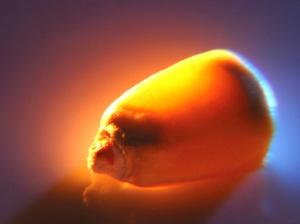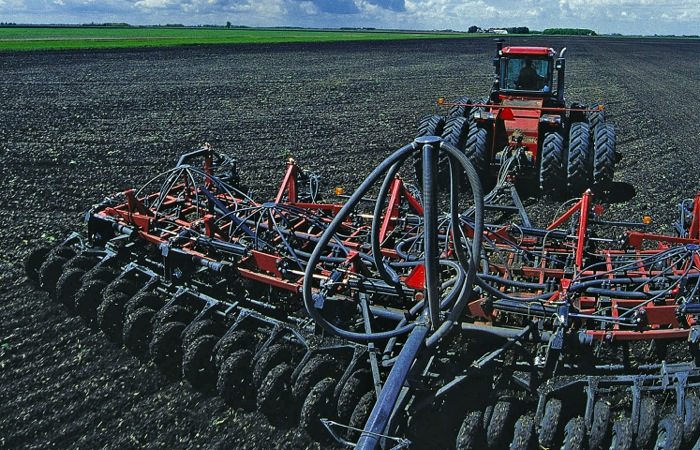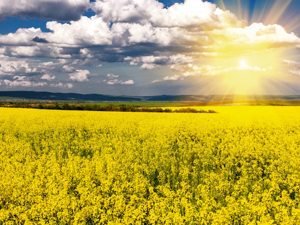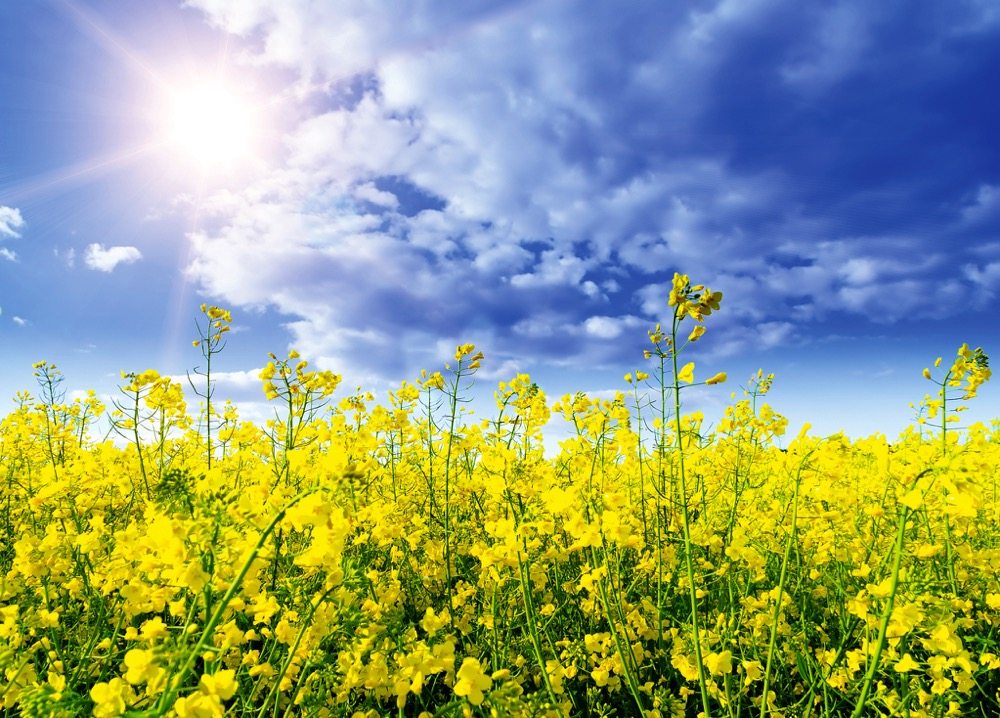A dry season: the good and bad new

To date, all indications are pointing to a dry spring, given the below-average precipitation received in many areas of the Prairies this winter. There are exceptions to every rule of course, but a lot of farmers had relatively dry soils going into winter, so we asked some agronomists and provincial crop experts what factors could influence cropping decisions in anticipation of a dry season.
1. Fertility

Jocelyn Velestuk, an agronomist with Western Ag, says she’s had a few conversations with Manitoba and Saskatchewan farmers about what they’re planning, going into a year with a very dry soil. “A lot of the farmers I speak with aren’t too worried and are putting inputs down just as they normally would,” she says. “Most of my customers are pulling fertility back based on starting with a dry soil, and an average to above average year for rainfall. They still want to put enough fertility down for the crop to take advantage of and are hopeful that the rains will come.”
She has also had some discussions about split nitrogen application and topping up nitrogen should rainfall come. “Application of in-crop fertilizer N should also be around the three to five weeks following seeding when the crop is taking up the majority of the nitrogen it needs to build yield,” she says. “If farmers are going to fertilize in-crop, I recommend applying before a rainfall (a half-inch to inch minimum) to wash the fertilizer into the soil where it can bind to the soil.”
Best nitrogen use efficiency is found if the nitrogen is washed into the ground directly following application, adds Velestuk. As well, nitrogen stabilizers can extend the period and reduce nitrogen losses. “Many farmers can find their best efficiencies through applying fertilizer at time of seeding, however some would like to manage risk,” she says. “Nutrients such as phosphorous and potassium do not move a lot in the soil, therefore there may be less risk if there is a poorer crop because those nutrients will likely be available for the next crop. This is where soil sampling and analysis is can really pay because if there are available nutrients in your soil, use them.”
2. Germination

Should soils remain dry, germination is also on farmers’ minds. “Finding the depth where there is enough moisture to germinate the seed is tricky in a dry soil. Some farmers choose to gamble and seed to a more shallow depth and hope for rains to come,” says Velestuk. “Earlier seeding may result in the seed sitting in a cold soil for longer, which can increase the risk of fungal infections. Quick germination and a healthy plant are integral to building a healthy crop.”
In terms of soil health, soils show their true nature in a drier year. “Soils higher in organic matter with good soil structure are able to withstand drought better than soils with compaction issues or soils that have been tilled or eroded,” says Velestuk. “Practices that increase soil health and add organic matter could be integral to farming operations moving forward, especially with more than one dry year in a row.”
Harry Brook, a crop specialist with Alberta Agriculture and Forestry, says he expects a lot of farmers have pretty much already decided what they are going to seed. “Although dry conditions last fall may have had a bearing, profitability still trumps everything else,” he says. “I don’t think there will be a whole lot of change in acreages. I expect a lot of acres still in canola and high acreages of wheat, which tends to be more drought resistant. I expect there will be lower acreages of pulses, mostly due to trade issues with India. In southern Alberta, irrigation opens up the different crops producers can grow.”
3. C4 weeds

With dry conditions there may not be weeds emerging pre-seeding. “Scouting is important, to determine if there are weed pressures to warrant a pre-seed spray,” says Breanne Tideman, a field agronomy/weed science research scientist with Agriculture and Agri-Food Canada at Lacombe, Alberta. “A timely, early season in-crop spray may be more economical than a pre-seeding spray if there aren’t any weeds.”
Obviously weeds that are better adapted to hot, dry conditions could present some problems for farmers in a dry year. Those are weeds with C4 metabolism, says Clark Brenzil, Saskatchewan’s provincial weed control specialist. “This C4 metabolism allows plants that have it to utilize CO² at lower concentrations than plants with the basic C3 metabolism,” he says.
Weeds that fit into the C4 type are grasses like green or yellow foxtail (wild millet), and barnyard grass as well as broadleaf weeds like kochia, Russian thistle, redroot pigweed and lamb’s-quarters.
Why is this important when we aren’t changing the CO² levels in the air? “Plants have openings in their leaves, called stomata, that they can open and close to allow for gas exchange and allow water vapour to escape, driving evapo-transportation, or the movement of water upward in the plant,” says Brenzil. “When water is scarce, plants close their stomata and it also restricts the amount of atmospheric components that they have access to in their internal leaf spaces. As a result, as photosynthesis progresses, CO² levels are drawn down inside the leaf.”
Because C4 plants can continue to produce sugars even at lower CO² levels, they will continue growing, even during periods of drought stress, for longer each day before slowing down. At night the stomata open when humidity is higher to replenish gases, and the process starts all over the next day. “What this means, however, is weeds with a C4 metabolism will outcompete C3 plants, which most of our main crops are with the exception of corn, sorghum and millets,” says Brenzil.
Some weeds like kochia and Russian thistle have other characteristics that adapt them to dry conditions. Kochia and foxtail barley (even though it is not a C4 plant) have dense hairs on the leaf surface that reduce the amount of evaporation from the leaf surface and improve tolerance of drier conditions. Russian thistle uses a round leaf structure instead of a flat leaf to minimize surface area for evaporation.
4. Herbicide rates

Weed control in drier conditions can also be tricky because moisture impacts how herbicides work. “The range of new, soil-active herbicides that have been introduced to the Prairies over the last 10 years may face challenges they have yet to experience,” says Brenzil. “Most of the newer soil-active herbicides rely entirely on rainfall to move them into the germination zone of the soil, which under a moist climate regime works well but if insufficient rainfall occurs in the spring some of these herbicide may not be sufficiently incorporated to do their job. We don’t know which ones will do well and which ones won’t as of yet.”
All plants will also have a heavier, waxy cuticle layer on their leaves in dry conditions as a way to prevent uncontrollable moisture loss from the surface of the leaf. This, in addition to a denser covering of hairs, will make it tougher for foliar herbicides to get into the plants.
“This is not the year to skimp on herbicide rates,” says Brenzil. “If plants are under moisture stress, herbicides tend not to work as well for other reasons. If a herbicide goes into a plant and the plant’s metabolism has stopped because of stress, the herbicide can break down or get bound up in the plant and less or no damage occurs to the plant when the metabolism starts working again. And because that metabolism is important for the crop in breaking down certain herbicides, injury can occur when the crop is under stress as well.”
How much rain will fall in the upcoming season is still one for the crystal ball. But, says Brenzil, what is already cast in stone in some areas, as a result of the lack of in-season rain last year, is the potential for herbicides, especially herbicides that already have a residual component, to not break down as fast as normally expected and cause injury to even certain labelled “safe” crops.
Mid-June to mid-September is a critical period for herbicide breakdown to occur since it is roughly the time that in-crop herbicides are applied and soils are warm enough for good soil microbial activity to occur. (Most herbicides are broken down by soil microbes). Beyond that time soils are too cold for rapid herbicide breakdown. “Each herbicide for which moisture may impact breakdown will have a different threshold for compensatory action to be taken and in regions that received three inches or less of rainfall during the June-September period last year, it is likely to impact the breakdown of most herbicides,” says Brenzil. “It is best if you have a concern about herbicide carryover to check with the manufacturer of the residual herbicide you applied last year and see if they can give you guidance on which crops are the most tolerant to residues of that herbicide. Producers can also check their provincial Crop Protection Guides for the herbicides that may be at risk of carryover.”
5. Seeding depth

Weather and environment certainly affect crop disease potential. In general terms, warm and wet or cool and wet conditions result in more disease, while cool and dry or hot and dry conditions produce less disease.
Dry conditions in spring may lead to a reduction in some diseases such as stripe rust and root rots, which are more prevalent in cool, wet conditions. “For example, the clubroot pathogen requires water films in the soil in order to initiate disease, so dry soils may reduce the impact of clubroot in some fields, depending on the inoculum levels,” says Michael Harding, a plant pathology research scientist with Alberta Agriculture and Forestry. “So, while drought is never what we hope for, the silver lining is that dry conditions often make it challenging for many of our plant pathogens to initiate disease and reduce yields.”
Holly Derksen, field crop pathologist with Manitoba Agriculture, cautions farmers not to seed too deep to try and access moisture this spring. “From a pathologist’s perspective seeding deeper can lead to more seedling disease issues,” she says. “The seedling has more soil to travel through before emergence and therefore has a better chance of coming into contact with a pathogen in the soil.”
In addition, the seedling will take longer to emerge. If a seed treatment is used there is a greater chance that the seed treatment will wear off while the plant is still in the seedling stage. “The lack of snow this winter may also indicate that early seeding could be an option,” says Derksen. “Seeding into soils that are cooler will also lead to delayed plant emergence which again may cause an issue considering seed treatment longevity.”
Fusarium root rot could also be an issue, especially if just enough moisture comes to allow initial infection. “After that, it actually thrives under drier conditions,” says Derksen. “In a dry year, it is important that root systems remain healthy and expansive to reach all the available moisture in the soil. Root rots can have a larger effect in dry years, even though symptoms may just be more severe drought symptoms by the plant.”
6. Scouting for insects

Drier-than-normal conditions would affect field scouting plans and priorities, and would favour some insects and reduce the risk of others, but not likely to the extent that it will result in growers switching cropping decisions as a result, says Manitoba Agriculture’s provincial entomologist, John Gavloski.
“Grasshopper survival is often better if we get drier weather. However, the grasshopper population was quite low during our survey in August last year, so I am not anticipating widespread economic populations, even if we get a drier year,” he says.
If the spring is very dry and crops are growing slowly cutworms may do more damage, so fields should be scouted for cutworms. Flea beetles could be more damaging to canola as well if the crop is struggling to grow early in the season. “It is always advised to scout canola for flea beetle feeding regardless of moisture levels in the spring, but if there are weather conditions that are highly deterring to early stand establishment scouting for flea beetle feeding takes on greater importance and should be done more frequently,” says Gavloski.
Rainfall can be a mortality factor for aphids. “Drier years could reduce aphid mortality caused by pathogens or being physically harmed by intense rainfall,” says Gavloski. “Many of our aphids don’t overwinter well in Manitoba though, so it is unpredictable whether they would be an issue anyway, and depends a lot on what blows in, and it’s not a reason to alter crop choices.”














